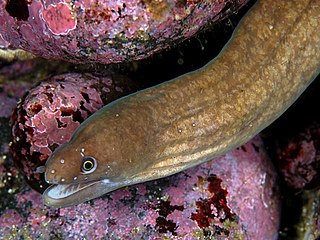
Moray eels, or Muraenidae, are a family of eels whose members are found worldwide. There are approximately 200 species in 15 genera which are almost exclusively marine, but several species are regularly seen in brackish water, and a few are found in fresh water.

Johann Jakob von Kaup was a German naturalist. A proponent of natural philosophy, he believed in an innate mathematical order in nature and he attempted biological classifications based on the Quinarian system. Kaup is also known for having coined popular prehistoric taxa like Pterosauria, Machairodus, Deinotherium, Dorcatherium, and Chalicotherium.

Gymnothorax is a genus of fish in the family Muraenidae found in Atlantic, Indian and Pacific Ocean. With more than 120 species, it the most speciose genus of moray eels.

Echidna is a genus of moray eels in the family Muraenidae.

Enchelycore is a genus of moray eels in the family Muraenidae. Enchelycore species are generally small to medium-sized eels, most ranging from 2 to 3 feet in length, with the largest being the Mosaic Moray, which reaches a length of 6 feet (180 cm). Members of the genus feature distinctive, curved jaws that prevent them from fully closing their mouth and aids them in catching, and holding on to prey. Enchelycore species can also feature extremely bright colors and ornate markings.

Anarchias is a genus of moray eels in the family Muraenidae.

Uropterygius is a genus of moray eels in the family Muraenidae.

Leptocephalus is a genus that was used for species of larval eels, called leptocephali, that were thought to be new fish species, or whose adult eel species were not known. Leptocephali differ so much in appearance from their adults that the larvae and adults of eels are not easily matched, and when first discovered, leptocephali were thought to be a distinct type of fishes, but not eels. Because of this, the genus designation of Leptocephalus was used for a while for unidentified leptocephali even after it was known that these were the larvae of eels thus becoming a "wastebasket taxon", but this practice is no longer used. Examples of marine congrid larvae, found in the western Indian Ocean and the Red Sea that were named this way are listed below. Only two species in two families are currently treated as having any validity, though the validity of L. bellottii is strongly in doubt.

The snowflake moray, also known as the clouded moray among many vernacular names, is a species of marine eel of the family Muraenidae. It has blunt teeth ideal for its diet of crustaceans, a trait it shares with the zebra moray.

Eels are ray-finned fish belonging to the order Anguilliformes, which consists of eight suborders, 20 families, 164 genera, and about 1000 species. Eels undergo considerable development from the early larval stage to the eventual adult stage and are usually predators.
Echidna leucotaenia, the whiteface moray, also known as the white-banded moray eel, is a moray eel. It was described by Schultz in 1943. It is a tropical, marine and freshwater eel which is known from the Indo-Pacific, including East Africa, the Line Islands, the Tuamotu Islands, and Johnston Island. It dwells at a depth range of 0 to 24 metres, and leads a benthic lifestyle in reefs. Males can reach a maximum total length of 75 centimetres (30 in).

Moringua is a genus of eels of the family Moringuidae that occur in shallow tropical and subtropical waters. It contains these described species:
Cirricaecula is a genus of eels in the snake eel family Ophichthidae.
The black-nostril false moray, blacknose false moray or blacknose reef eel, is an eel in the family Chlopsidae. It was described by Leonard Peter Schultz in 1953. It is a tropical, marine eel which is known from throughout the Indo-Pacific, including the Chagos Islands, Samoa, the Ryukyu Islands, the southern Great Barrier Reef, and Micronesia. It typically dwells in coral reefs at depths greater than 14 m. They can reach a maximum total length of 12 cm (4.7 in).
The shortfin false moray is an eel in the family Chlopsidae. It was described by Leonard Peter Schultz in 1953. It is a tropical, marine eel which is known from American Samoa, Samoa, Australia, Fiji, French Polynesia, Indonesia, the Marshall Islands, New Caledonia, Palau, Papua New Guinea, the Solomon Islands, and Wallis and Futuna. It typically dwells in seaward and lagoon coral reefs at an approximate depth of 43 m. Males can reach a maximum total length of 13 centimetres (5.1 in).
The common false moray, false moray, grey reef eel, or plain false moray,, is an eel in the family Chlopsidae. It was described by Leonard Peter Schultz in 1943. It is a tropical, marine eel which is known from seaward reefs in the Indo-Pacific regions. It typically dwells at a depth around 56 metres (184 ft). Males can reach a maximum total length of 30 centimetres (12 in).
Kaupichthys hyoproroides, the false moray, common false moray, grey reef eel, reef eel, plain false moray, or double-toothed xenocongrid eel, is an eel in the family Chlopsidae. It was described by Pehr Hugo Strömman in 1896, originally under the genus Leptocephalus. It is a subtropical, marine eel which is known from coral reefs and rocky shores in the western Atlantic Ocean, including southeastern Florida, USA; the Bahamas, Yucatan, Mexico; the Antilles, and Venezuela. It is a benthic, solitary eel that typically dwells at depths to 95 m. Males can reach a maximum total length of 30 cm.
Kaupichthys japonicus is an eel in the family Chlopsidae. It was described by Kiyomatsu Matsubara and Hirotoshi Asano in 1960. It was originally a subspecies of Kaupichthys diodontus. It is a tropical, marine eel which is known from Japan and the South China Sea, in the western Pacific Ocean. Males can reach a maximum total length of 23.8 centimetres (9.4 in). K. japonicus spawns in the summer.










